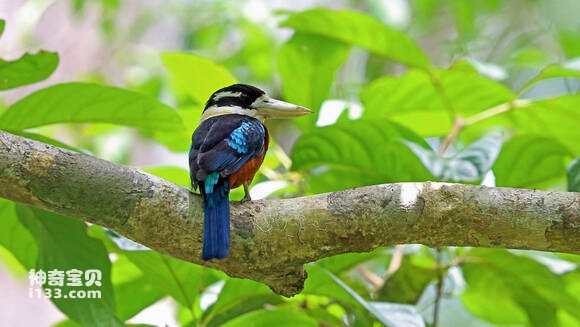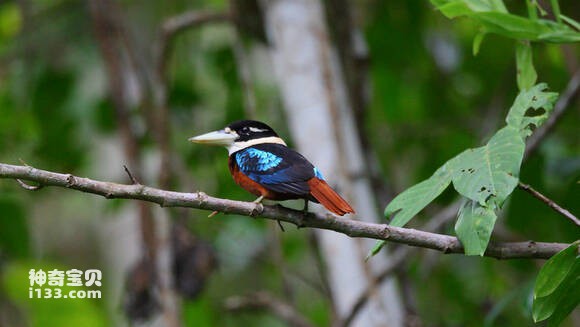Dacelo gaudichaud
IUCN
LCBasic Information
Scientific classification
- name:Dacelo gaudichaud
- Scientific Name:Dacelo gaudichaud,Rufous-bellied Giant Kingfisher,Rufous-bellied kookaburra
- Outline:Climbing birds
- Family:
Vital signs
- length:28-31cm
- Weight:110-170g
- lifetime:About 20 years
Feature
It can produce seven different sounds, similar to the rhythm of music
Distribution and Habitat
It is the most common and widespread bird in New Guinea. It inhabits coastal forests or monsoon forests. Living among the bouquets of trees, planted teak, bushes near the coast, flooded forests, mangroves and gardens. It can be found anywhere from 500 to 1,300 meters.
Appearance
The brown-bellied kingfisher is 28-31cm long, the female weighs 110-161 g, and the male 138-170 g. The male bird has a white collar and a tea-yellow color on the nape. The black hat on the top of the head is slightly shiny. There are two small white spots on the head: one at the base of the mouth and the other behind the eyes. The underbody is cinnamon red. Upper back, shoulder blades black. Bright blue skies on the lower back, tail and above. The tail is dark blue and black. The mouth is white or pale yellowish-gray. The legs are dark gray. The female is similar to the male except for the reddish-brown tail. The young birds resemble the females, but their beaks and feathers are gray.
Mouth thick straight, long and firm, mouth ridge round; No nasal furrow; The wingtip is long, the first primary feathers are slightly shorter, and the third and fourth feathers are longest; Tail short round; The body feathers are showy and luminous, often blue or green. The head is large, the neck is s
Details
The Rufous-bellied Giant Kingfisher and Rufous-bellied kookaburra have no subspecies.

The brown-belted Kookaburra feeds mainly on insects and other invertebrates. Generally live in a family unit. Perched among the trees, chasing forest lizards and large insects. In order to feed, they sometimes descend to the ground and dig. Even stranger, they have developed into unusual game birds that also prey on nesting sparrows. Their method of capturing prey, which is to perch and raid, is to settle quietly in a high vantage point, keeping a close eye on the ground. Once they find their prey, they flutter down, pounce on it, hold it tightly in their beak, and fly back to their perch to devour it. If there are young birds, they eventually return to the nest to feed them.
The brown bellies Kookaburra can make 7 different sounds, similar to the rhythm of music:
1. 'tchok' or 'tchok', strong and repeated, such as crying.
2. 'Toto, toto, Toto' or 'neck Couci', quickly and periodically repeat every two seconds.
3. At intervals of one or two per second, make a series of 5 to 20 strong Hess barks and high pitched sounds.
4. Continuous rattle sound can be emitted during flight.
5. Shout 'Eliou-Eliou-Eliou' at a rapid rate of 3 to 6.
6. Shout when chasing another species, as a deterrent cry.
7. Make a collective low whistle call that looks very much like a chorus blue-winged Kookaburra.

The brown bellies Kookaburra are sedentary and occupy the same "territory" all year round. Nesting in hollow trees destroyed by termites. Male and female adults help each other take care of their young. They attach great importance to "family values" and often "stay together" with their partners. Brown belly Kookaburra birth rate is low, long life, generally can survive about 20 years. The adult brown-belted Kookaburra usually spends a long time rearing its young until it is able to live on its own, thus producing up to one litter in a season. Although there may be competition among young birds of the same genus, the adult kookaburra usually tries to help the adult to raise the next generation of young birds, so that the whole family is still tightly knit.
Listed in the International Union for Conservation of Nature Red List of Threatened Species (IUCN) for 2016 ver 3.1 - Not Threatened (LC).
Protect wild animals and eliminate wild meat.
Maintaining ecological balance is everyone's responsibility!








